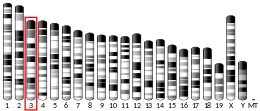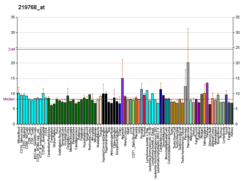VTCN1
V-set domain-containing T-cell activation inhibitor 1 is a protein that in humans is encoded by the VTCN1 gene.[5][6][7]
Function
B7H4 belongs to the B7 family (see CD80; MIM 112203) of costimulatory proteins. These proteins are expressed on the surface of antigen-presenting cells and interact with ligands (e.g., CD28; MIM 186760) on T lymphocytes.[supplied by OMIM][7]
B7-H4 is an immune checkpoint molecule.
gollark: Discord servers above 10000 members or so == uncool
gollark: Anyway, I was thinking about an ABR game where you have to submit a (fixed, real, base 10) integer (or maybe floating point, whatever) which is as close as possible to 80% of the average of all people's picks.
gollark: Added to your alphabetical profile.
gollark: Apiochronoforms working as intended.
gollark: Brain[REDACTED] sine wave generator WHEN?
See also
References
- GRCh38: Ensembl release 89: ENSG00000134258 - Ensembl, May 2017
- GRCm38: Ensembl release 89: ENSMUSG00000051076 - Ensembl, May 2017
- "Human PubMed Reference:". National Center for Biotechnology Information, U.S. National Library of Medicine.
- "Mouse PubMed Reference:". National Center for Biotechnology Information, U.S. National Library of Medicine.
- Sica GL, Choi IH, Zhu G, Tamada K, Wang SD, Tamura H, Chapoval AI, Flies DB, Bajorath J, Chen L (June 2003). "B7-H4, a molecule of the B7 family, negatively regulates T cell immunity". Immunity. 18 (6): 849–61. doi:10.1016/S1074-7613(03)00152-3. PMID 12818165.
- Prasad DV, Richards S, Mai XM, Dong C (June 2003). "B7S1, a novel B7 family member that negatively regulates T cell activation". Immunity. 18 (6): 863–73. doi:10.1016/S1074-7613(03)00147-X. PMID 12818166.
- "Entrez Gene: VTCN1 V-set domain containing T cell activation inhibitor 1".
Further reading
- Maruyama K, Sugano S (January 1994). "Oligo-capping: a simple method to replace the cap structure of eukaryotic mRNAs with oligoribonucleotides". Gene. 138 (1–2): 171–4. doi:10.1016/0378-1119(94)90802-8. PMID 8125298.
- Suzuki Y, Yoshitomo-Nakagawa K, Maruyama K, Suyama A, Sugano S (October 1997). "Construction and characterization of a full length-enriched and a 5'-end-enriched cDNA library". Gene. 200 (1–2): 149–56. doi:10.1016/S0378-1119(97)00411-3. PMID 9373149.
- Watanabe N, Gavrieli M, Sedy JR, Yang J, Fallarino F, Loftin SK, Hurchla MA, Zimmerman N, Sim J, Zang X, Murphy TL, Russell JH, Allison JP, Murphy KM (July 2003). "BTLA is a lymphocyte inhibitory receptor with similarities to CTLA-4 and PD-1". Nature Immunology. 4 (7): 670–9. doi:10.1038/ni944. PMID 12796776.
- Zang X, Loke P, Kim J, Murphy K, Waitz R, Allison JP (September 2003). "B7x: a widely expressed B7 family member that inhibits T cell activation". Proceedings of the National Academy of Sciences of the United States of America. 100 (18): 10388–92. doi:10.1073/pnas.1434299100. PMC 193571. PMID 12920180.
- Choi IH, Zhu G, Sica GL, Strome SE, Cheville JC, Lau JS, Zhu Y, Flies DB, Tamada K, Chen L (November 2003). "Genomic organization and expression analysis of B7-H4, an immune inhibitory molecule of the B7 family". Journal of Immunology. 171 (9): 4650–4. doi:10.4049/jimmunol.171.9.4650. PMID 14568939.
- Brandenberger R, Wei H, Zhang S, Lei S, Murage J, Fisk GJ, Li Y, Xu C, Fang R, Guegler K, Rao MS, Mandalam R, Lebkowski J, Stanton LW (June 2004). "Transcriptome characterization elucidates signaling networks that control human ES cell growth and differentiation". Nature Biotechnology. 22 (6): 707–16. doi:10.1038/nbt971. PMID 15146197.
- Salceda S, Tang T, Kmet M, Munteanu A, Ghosh M, Macina R, Liu W, Pilkington G, Papkoff J (May 2005). "The immunomodulatory protein B7-H4 is overexpressed in breast and ovarian cancers and promotes epithelial cell transformation". Experimental Cell Research. 306 (1): 128–41. doi:10.1016/j.yexcr.2005.01.018. PMID 15878339.
- Kimura K, Wakamatsu A, Suzuki Y, Ota T, Nishikawa T, Yamashita R, Yamamoto J, Sekine M, Tsuritani K, Wakaguri H, Ishii S, Sugiyama T, Saito K, Isono Y, Irie R, Kushida N, Yoneyama T, Otsuka R, Kanda K, Yokoi T, Kondo H, Wagatsuma M, Murakawa K, Ishida S, Ishibashi T, Takahashi-Fujii A, Tanase T, Nagai K, Kikuchi H, Nakai K, Isogai T, Sugano S (January 2006). "Diversification of transcriptional modulation: large-scale identification and characterization of putative alternative promoters of human genes". Genome Research. 16 (1): 55–65. doi:10.1101/gr.4039406. PMC 1356129. PMID 16344560.
- Kryczek I, Zou L, Rodriguez P, Zhu G, Wei S, Mottram P, Brumlik M, Cheng P, Curiel T, Myers L, Lackner A, Alvarez X, Ochoa A, Chen L, Zou W (April 2006). "B7-H4 expression identifies a novel suppressive macrophage population in human ovarian carcinoma". The Journal of Experimental Medicine. 203 (4): 871–81. doi:10.1084/jem.20050930. PMC 2118300. PMID 16606666.
- Kryczek I, Wei S, Zou L, Zhu G, Mottram P, Xu H, Chen L, Zou W (July 2006). "Cutting edge: induction of B7-H4 on APCs through IL-10: novel suppressive mode for regulatory T cells". Journal of Immunology. 177 (1): 40–4. PMID 16785496.
- Krambeck AE, Thompson RH, Dong H, Lohse CM, Park ES, Kuntz SM, Leibovich BC, Blute ML, Cheville JC, Kwon ED (July 2006). "B7-H4 expression in renal cell carcinoma and tumor vasculature: associations with cancer progression and survival". Proceedings of the National Academy of Sciences of the United States of America. 103 (27): 10391–6. doi:10.1073/pnas.0600937103. PMC 1502468. PMID 16798883.
- Chen Y, Yang C, Xie Z, Zou L, Ruan Z, Zhang X, Tang Y, Fei L, Jia Z, Wu Y (December 2006). "Expression of the novel co-stimulatory molecule B7-H4 by renal tubular epithelial cells". Kidney International. 70 (12): 2092–9. doi:10.1038/sj.ki.5001867. PMID 17051145.
- Simon I, Katsaros D, Rigault de la Longrais I, Massobrio M, Scorilas A, Kim NW, Sarno MJ, Wolfert RL, Diamandis EP (August 2007). "B7-H4 is over-expressed in early-stage ovarian cancer and is independent of CA125 expression". Gynecologic Oncology. 106 (2): 334–41. doi:10.1016/j.ygyno.2007.03.035. PMID 17498784.
- Miyatake T, Tringler B, Liu W, Liu SH, Papkoff J, Enomoto T, Torkko KC, Dehn DL, Swisher A, Shroyer KR (July 2007). "B7-H4 (DD-O110) is overexpressed in high risk uterine endometrioid adenocarcinomas and inversely correlated with tumor T-cell infiltration". Gynecologic Oncology. 106 (1): 119–27. doi:10.1016/j.ygyno.2007.03.039. PMID 17509674.
This article is issued from Wikipedia. The text is licensed under Creative Commons - Attribution - Sharealike. Additional terms may apply for the media files.




